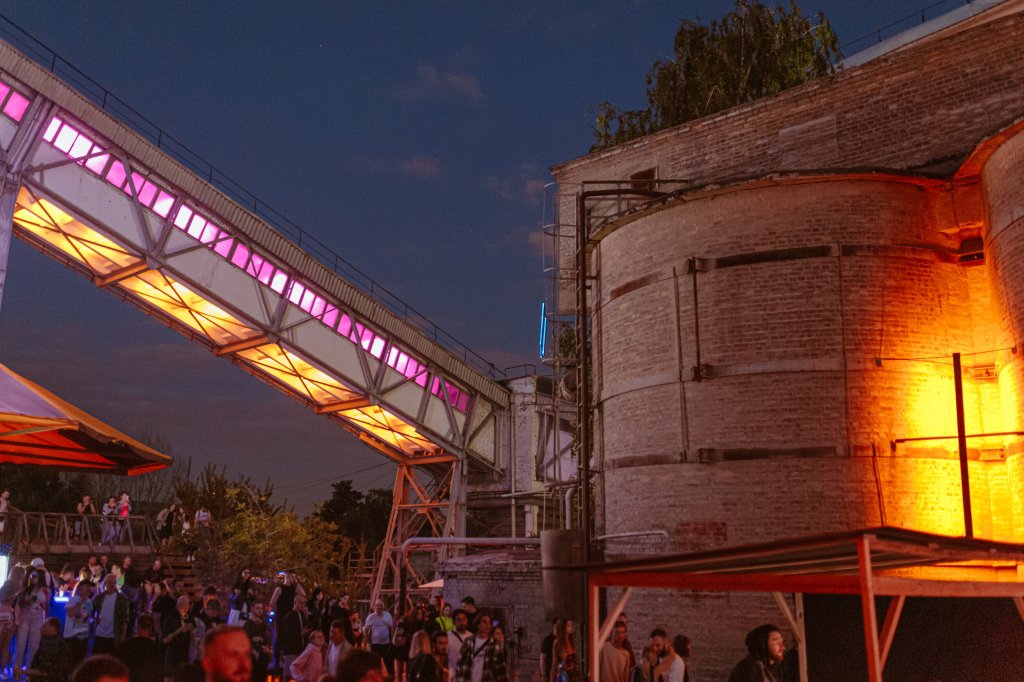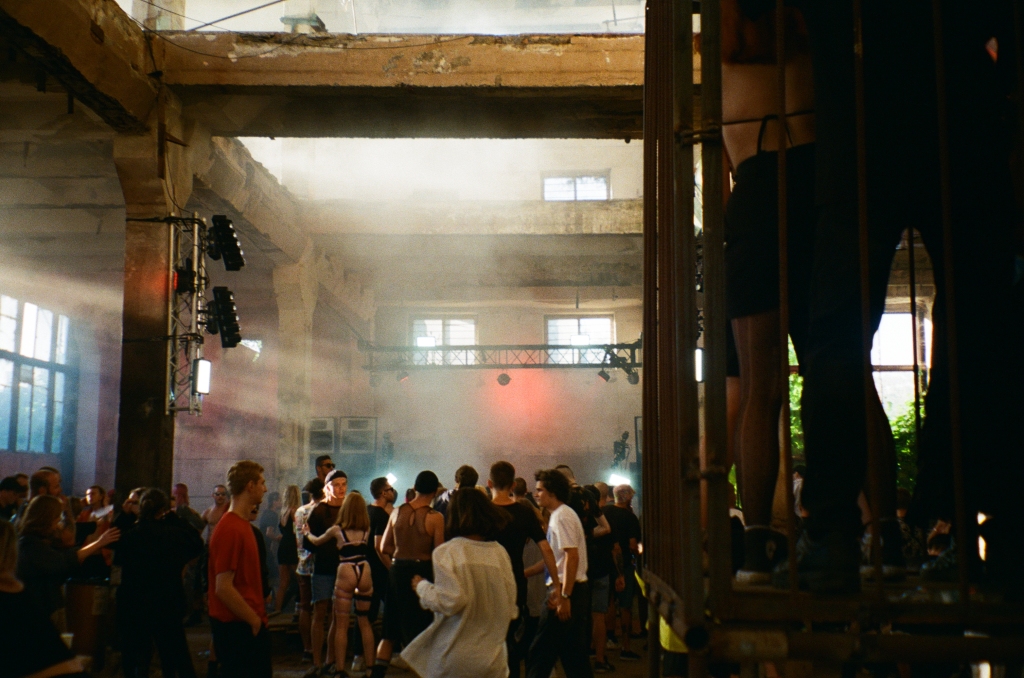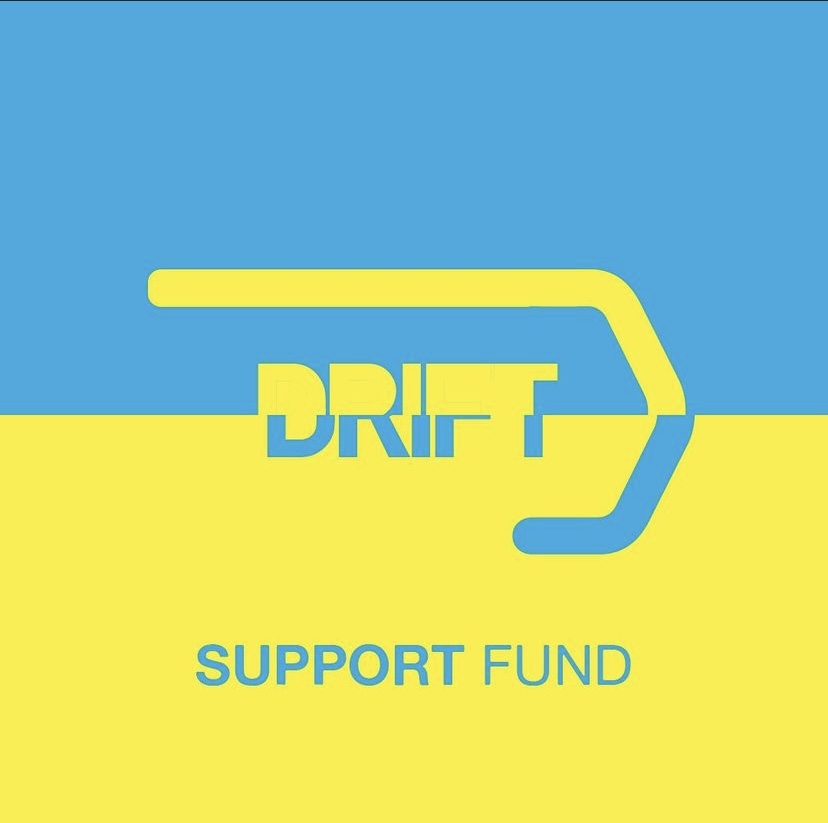Photo: Club ∄, by David Wouters
After Russia invaded Ukraine on the 24th of February, a number of clubs, bars and institutions have set-up funds to directly support people and initiatives of the community. In this article we dive into the ever-growing electronic music scene before the war, about how we can not look the other way when the party’s over, which collectives have set-up community funds, what initiatives they are raising money for, how they are supporting the community and we provide an overview of where to donate to.
Before Russia’s invasion in Ukraine, Kyiv was on its way of becoming the beating heart for underground electronic music culture. After the Euromaidan revolution in 2014, followed by the Revolution of Dignity, the annexation of Crimea and the start of Russia’s war in the east of Ukraine, Kyiv experienced a rave-revival and the electronic music scene was growing in an accelerating rate.
It was collective схема (pronounced ‘Skhema’) that organized raves in post-industrial locations all over the city with locations ranging from skateparks to warehouses. Meanwhile, located in a former ribbon factory, the city’s most popular club for electronic music ‘Closer’ continued to organize events. In 2016 the club organized its first 30-hour festival named ‘Strichka’ (meaning ribbon), taking place in the halls, bars, open spaces and several (outdoor) dance floors of the creative hub. In the beginning of 2015, collective Rhythm Büro emerged and organized secret raves, paving the way for other rave collectives by finding unique locations under bridges, film studios or in nature.

In the same year hangout bar HVLV (pronounced ‘Khvylovy’) opened up its doors after closing and opening up a couple of times, over the years it became the hotspot for creatives and DJs. In 2017, the first annual edition of Brave! Factory Festival took place on the premises of a former subway enterprise named ‘Kyivmetrobud’, inviting more than 80 national and international electronic music projects and becoming one of Kyiv’s most awaited events. In those years of the growing electronic music scene, DJ Stas Tweeman experienced a lack of queer representation when it came to parties. In 2018, he therefore organized ‘Veselka’, the first queer and sex-positive rave of Kyiv. The party quickly attracted queers from all over Ukraine and the collective organized parties with renowned collectives like Herrensauna and Cocktail d’Amore.

In 2019, DJ Nastia launched record label ‘NECHTO‘ and shortly after in 2020 organized its first events in warehouses with over 3000 people. In November 2019, right before the pandemic, club and cultural institution ‘∄’ (the club with no name, also named ‘K41’, after its street name ‘Kyrylivska Street 41’) opened its doors. The club is located in a former brewery built in 1887, and was designed by studio Karhard, the architects behind Berghain. K41 became more than a club, it became the beacon for progressive youth and electronic music culture in Kyiv, exploring new formats of safe spaces and clubbing. DJs all over the world have named it one of their favourite clubs. The cultural institution also hosted a number of panels and DJ school ‘Module Exchange’. A little further down the street on number 71, bar and club Keller opened it’s post-industrial space in 2021 to the intense, eclectic and free rave ‘DRIFT’, a concept focussing on creating after-hour events in the city.

On the opposite side at Kyrylivska Street number 61, Collider opened its doors. On a premises of 33,000m2 in a former silk factory, this creative cluster created a silicon valley effect for the electronic music industry, housing Funktion-One representatives, a DJ academy, labels, artists and sound engineers. In the same year record store ‘The K Hole’ opened its doors, the shop became the first record store for harder electronic music in Kyiv. On July 9th, 2021, club Arsenal XXII opened its doors in the heart of a former weapon forgery built in 1764. This was also the year that the team behind the Georgian club Bassiani, organized the first edition of a three-day festival named ICKPA (pronounced ISKRA) Festival with an exciting line-up at a former Sanatorium named ‘Khvylia’, attracting visitors from all over.
It’s safe to say that in the past three years Kyiv became the city to connect the west of Europe with eastern post-socialist countries. Visitors from all over came to explore the rich cultural offer and indulge in nightlife. Word hit the street as Kyiv’s visitors came home to tell their friends about an electronic music scene they had never experienced before; praising the scene for amongst other things the innovating way of doing things, its beautifully designed spaces, its friendly crews and crowds and its stellar line-ups.

This ever-growing scene came to a halt when Russia invaded Ukraine on the 24th of February. The Russian aggression has seen the community displaced, while others have stayed and joined the territorial defence forces. Clubs, collectives, institutions and people from the community have set-up funds to support people from the community and financially support hundreds of other initiatives in Ukraine.
Within the international electronic music community, we are hyper-mobilized and visit other’s scenes on a regular basis. International friendships are formed and the communities become attached to places abroad. It’s important to celebrate each other’s flourishing scenes, but it’s even more important to support those places held dear when they are not. In response, a numerous amount of collectives and DJs internationally are directly supporting these funds with money from their parties or gigs.
Below is an overview of the different initiatives from the electronic music scene in Kyiv who need your support. Find out what each collective is doing. Each fund is transparent about their spending, giving you direct information as to where your money goes to.
HVLV: Podil Underground Community Foundation

On the 15th of April, hangout and music bar HVLV has organized an initiative named FUNDRADIO. In a secret studio located in the district of Podil, the project will stream DJ sets, interviews and storytelling. As stated on their Instagram, ‘Together with guests we will talk about life in the capital during wartime, and about our social, historical and political vision of war and music’.
On the website of HVLV, the bar states the following
‘’Regardless of where the war caught us and what kind of destruction the Russian regime is currently inflicting on us, we believe in the Armed Forces of Ukraine and our victory. However, as agents of cultural front, we understand that victory is not enough. We need to prepare for the reconstruction of our state and the resumption of cultural activities, to strengthen not only our territorial but also our cultural borders.’’
All donations to the stream will directly support the newly formed ‘Podil Underground Community Foundation’. The fund will raise money for the humanitarian and infrastructural needs of Podil and to support the Ukrainian army. Donations will go directly to volunteers to buy medicine, first aid kits, electronics, equipment and food. 50% of each stream will also directly support the functioning of the bar, team and local artists.
The stream starts daily at 4.20 PM on their YouTube channel.

As stated on their website, the cultural institution and club has set up a fund to help some of the 16.000+ members of the community, Ukrainian artists and the more than 150 employees of the space. By donating to their fund, K41 is directly able to support them with finding a safe place in Ukraine or abroad, transport, facilitating jobs in the EU, organizing housing, psychological help and financial support.
Furthermore, K41 has been able to set-up a Telegram bot. The app uses a bot that sorts people’s requests on basis of the type of support required.
On March 23, the team posted a statement on GoFundMe about the initiatives they so far have been able to help: ”We would like to thank everyone for the overwhelming support and donations to the ∄ Community Fund. With your help, so far, we’ve been able to assist over 1150 people via our Telegram bot. Aside from financial help to 790 people, we’ve been able to allow evacuation abroad and within Ukraine, as well as accommodation for the members of our community and their families.
With the resources from the ∄ Community Fund, so far our team has been able to provide people currently staying in Kyiv with 2700 meals, organize 16 trips for supplies and medicine to the border inside Ukraine, as well as 2 trips with supplies to the border from the Polish side. So far, our team has been able to organize temporary shelter for over 90 displaced people within Ukraine and abroad. The money from the ∄ Community Fund has been used to purchase train, bus and plane tickets, clothes, sim-cards and other basic necessities. Currently we are working on further developing the bot and finding new possibilities to help those in need.’’

Founders of the DRIFT support fund Olha Korovina and her partner Jean-Philippe Doho, posted the following statement on their website:
‘DRIFT is a transcultural community platform and event series born in Kyiv in March 2021. On the 24th of February 2022 Russia launched a full-scale military invasion of Ukraine. Our community stays strong and determined to stay free and independent from Putin. In the beginning of Spring one year ago we raised money to organise our first DRIFT event in Kyiv. This country is part of us. We can’t just use it as a party zone and turn away from it when the people we love so much are suffering. So we ask you to trust us and our community, to defend, help, rebuild this beautiful country. The DRIFT Support Fund is here to help with concrete urgent actions, as well as future necessities. We are giving full transparency on the actions we take with the money you donate, updating you about the individuals, organisations that we support.’
So far, the Drift Support fund regularly posts an update on their Instagram about the initiatives they have been able to help with the money raised. Amongst others, money has gone to an initiative setting up production of bulletproof vests in Kyiv. To intiatives making food for medical institutions in Kyiv. To an initiative that has set up a private humanitarian warehouse in Kyiv, personally supplying territorial defence forces in Irpin and Bucha. To an initiative providing food and supplies for a refugee humanitarian centre in Berlin. Money for supplies for the Territorial Defence Forces in Odessa. Donations went to logistics, receiving supplies from Europe in Lviv and distributing them to other cities in Ukraine. To convoys and to financially support people from the community and their families.
The former silk factory housing an electronic music community of DJs, labels, promotors, a DJ school, sound engineers and light artists is raising money for the Ukrainian resistance. The money raised goes to military equipment for the Territorial Defence Forces.


Leave a comment